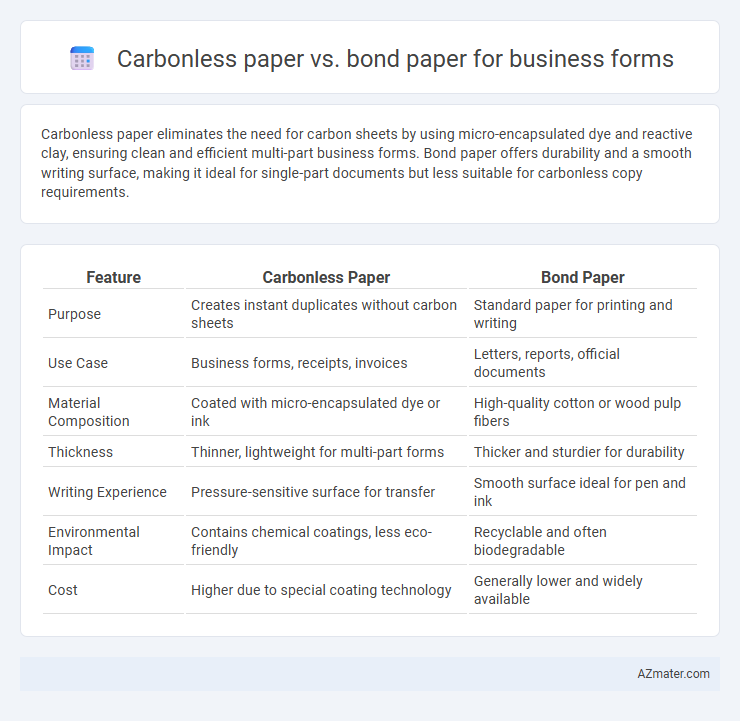Carbonless paper eliminates the need for carbon sheets by using micro-encapsulated dye and reactive clay, ensuring clean and efficient multi-part business forms. Bond paper offers durability and a smooth writing surface, making it ideal for single-part documents but less suitable for carbonless copy requirements.
Table of Comparison
| Feature | Carbonless Paper | Bond Paper |
|---|---|---|
| Purpose | Creates instant duplicates without carbon sheets | Standard paper for printing and writing |
| Use Case | Business forms, receipts, invoices | Letters, reports, official documents |
| Material Composition | Coated with micro-encapsulated dye or ink | High-quality cotton or wood pulp fibers |
| Thickness | Thinner, lightweight for multi-part forms | Thicker and sturdier for durability |
| Writing Experience | Pressure-sensitive surface for transfer | Smooth surface ideal for pen and ink |
| Environmental Impact | Contains chemical coatings, less eco-friendly | Recyclable and often biodegradable |
| Cost | Higher due to special coating technology | Generally lower and widely available |
Introduction: Understanding Carbonless Paper and Bond Paper
Carbonless paper uses micro-encapsulated dye or ink that reacts upon pressure, eliminating the need for carbon sheets, making it ideal for multi-part business forms requiring instant duplicate copies. Bond paper, a high-quality, durable paper typically made from cotton fibers, offers a smooth surface suited for printing standard business documents and forms without the pressure-sensitive duplication feature. Choosing between carbonless and bond paper depends on the necessity for automatic copy creation versus standard printing quality and document appearance.
Key Differences Between Carbonless and Bond Paper
Carbonless paper and bond paper differ primarily in their use and composition; carbonless paper contains micro-encapsulated dye that reacts under pressure to create instant copies, making it ideal for multi-part business forms without carbon sheets. Bond paper, typically made from cotton fiber, offers durability and a smooth finish suited for official documents, letters, and printed business forms where a single original is needed. Carbonless reduces mess and increases efficiency in duplicate form creation, while bond paper provides a premium, archival quality ideal for high-quality printing and long-term preservation.
How Carbonless Paper Works in Business Forms
Carbonless paper in business forms operates through micro-encapsulated dye or ink on the back of the top sheet and a reactive clay or dye on the front of the sheets below, creating instant copies without the need for carbon sheets. This chemical reaction transfers the writing pressure from the original sheet to subsequent sheets, producing clear duplicates efficiently for invoices, receipts, and purchase orders. Bond paper, by contrast, does not facilitate copy creation through pressure-sensitive reactions and is typically used for original documents or non-duplicate forms.
Bond Paper in Business Forms: Strengths and Applications
Bond paper offers superior durability and smooth surface texture, making it ideal for high-quality business forms that require frequent handling and readability. Its strong fiber composition resists tearing and ink bleed-through, ensuring professional presentation and long-lasting records in financial documents, contracts, and official correspondence. Widely used in printing invoices, purchase orders, and legal agreements, bond paper supports reliable multi-part forms when combined with carbonless paper layers.
Print Quality: Carbonless vs Bond Paper
Carbonless paper delivers sharp, clear prints essential for multi-part business forms where precise legibility across copies is critical. Its micro-encapsulated dye technology ensures consistent print quality without smudging, unlike bond paper which may require additional ink drying time and can produce less distinct copies when used with carbonless transfers. Businesses favor carbonless paper for reliable, high-quality duplicates, while bond paper suits single-copy documents needing crisp, clean prints.
Cost Comparison: Carbonless Paper vs Bond Paper
Carbonless paper typically incurs higher initial costs than bond paper due to the special coatings that enable duplicate copies without carbon sheets, but it reduces long-term expenses by streamlining document handling and minimizing the need for additional materials. Bond paper is more cost-effective upfront and widely used for general printing, yet it requires separate carbon sheets or manual copying, which can increase operational costs over time. Businesses must consider volume and efficiency needs, as carbonless paper offers a better return on investment in high-volume, multi-copy form scenarios compared to bond paper.
Environmental Impact: Sustainability Considerations
Carbonless paper, often used for multi-part business forms, contains chemical coatings that enable ink transfer without carbon sheets but may pose environmental concerns due to the use of potentially toxic substances and limited recyclability. Bond paper, typically made from wood pulp, is more widely recyclable and biodegradable, offering a more sustainable option for business forms, especially when sourced from FSC-certified or recycled materials. Choosing bond paper with eco-friendly certifications reduces overall environmental impact and supports sustainable business practices.
Durability and Storage Longevity
Carbonless paper offers moderate durability suited for short-term business forms but may yellow and degrade faster over time, impacting storage longevity. Bond paper, especially archival-grade types, provides superior durability and resistance to aging, making it ideal for long-term storage and record-keeping. For business forms requiring extended preservation, bond paper ensures clarity and longevity unmatched by carbonless alternatives.
Suitability for Different Business Form Types
Carbonless paper excels for multi-part business forms requiring instant duplicates without messy carbon sheets, making it ideal for receipts, invoices, and order forms where clear, simultaneous copies are essential. Bond paper suits single-use documents like contracts, letters, or standalone forms that prioritize durability and professional presentation over duplicate creation. Businesses choosing paper depend on operational needs: carbonless for efficient multi-copy forms, bond for high-quality, standalone documents.
Choosing the Right Paper for Your Business Needs
Carbonless paper provides instant duplicate or triplicate copies without messy carbon sheets, making it ideal for multi-part business forms like invoices and receipts. Bond paper offers a smooth, durable surface suitable for high-quality printing and official documents where clarity and professionalism are key. Selecting the right paper depends on your business's need for multiple copies versus printing quality and presentation.

Infographic: Carbonless paper vs Bond paper for Business form
 azmater.com
azmater.com